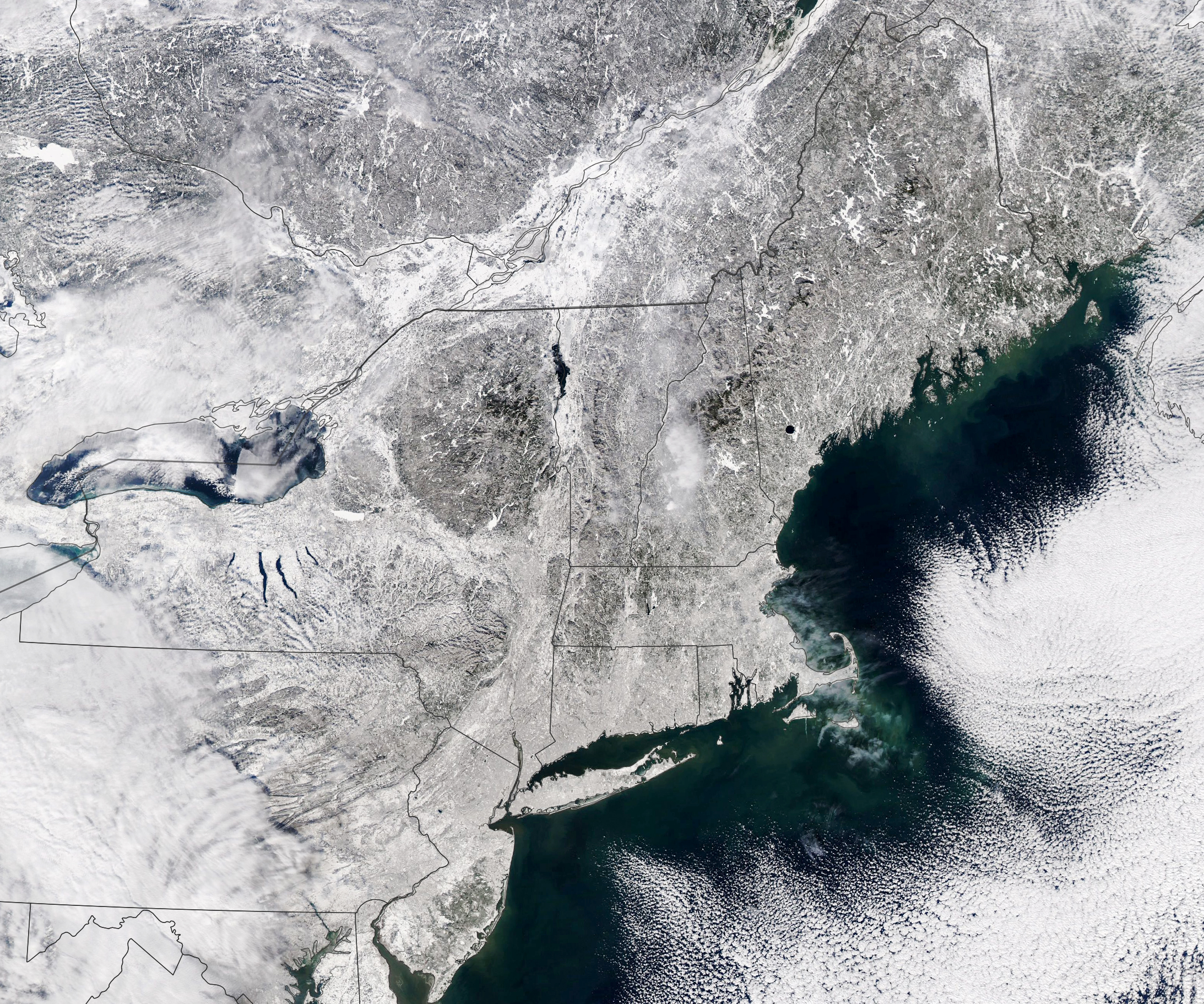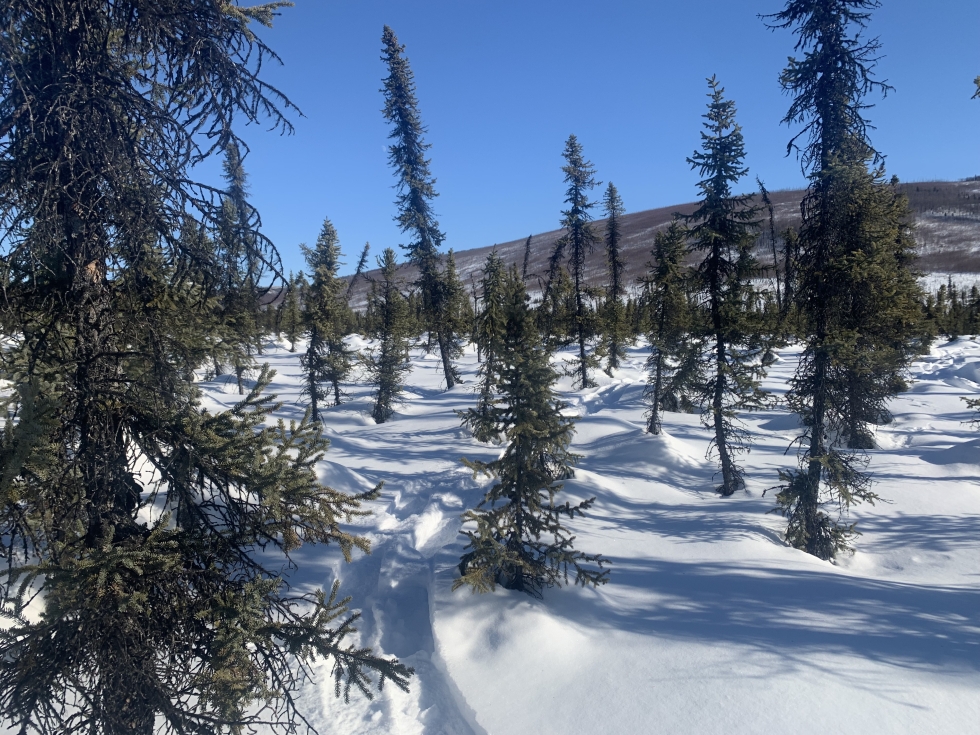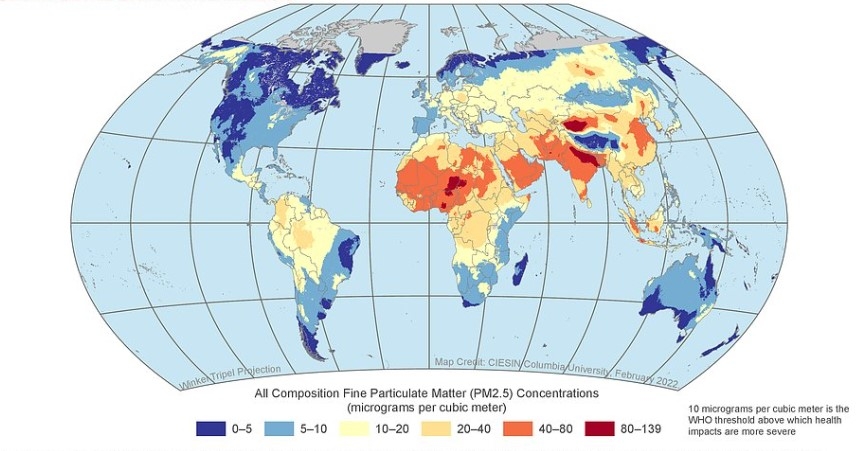Alaska Satellite Facility Distributed Active Archive Center (ASF DAAC)
ASF DAAC Launches SIR-C Dataset Landing Page
NASA's ASF DAAC has launched a new dataset landing page providing access to 1994 Spaceborne Imaging Radar C (SIR-C) data products. These beta data products, originally captured during the SIR-C mission that took place from April to October 1994, have been transitioned to the cloud for enhanced accessibility and operational use. The new landing page offers users a centralized resource to explore this valuable dataset and enables researchers to leverage SIR-C data for various scientific applications.
Learn more about the new SIR-C dataset landing page
Sentinel-1 Orbits Available in Amazon S3
Sentinel-1 orbit files are now available in Amazon S3 and the Registry of Open Data on AWS. These Sentinel-1 Precise Orbit Determination (POD) products, which are a necessary auxiliary input for nearly all Sentinel-1 data processing workflows, contain auxiliary data on satellite position and velocity for the European Space Agency's Sentinel-1 mission.
Learn more about Sentinel-1 orbit files in Amazon S3
New Tutorials for Working with NISAR Sample Data
A new series of tutorials demonstrating how users can work with sample NASA/ISRO (Indian Space Research Organisation) Synthetic Aperture Radar (NISAR) data products is available. These tutorials provide instruction on working with the NISAR data in a GIS environment (such as ArcGIS Pro and QGIS), exploring the data using Panoply, and transforming the data using Geospatial Data Abstraction Library (GDAL) commands.
Learn more about the new NISAR data tutorials
Atmospheric Science Data Center (ASDC)
New STAQS Datasets
NASA's ASDC released a suite of datasets from the Synergistic TEMPO (Tropospheric Emissions: Monitoring of Pollution) Air Quality Science (STAQS) mission. Conducted primarily over urban areas during the summer of 2023, the STAQS mission sought to integrate TEMPO satellite observations with traditional air quality monitoring, to improve understanding of air quality science and enhance societal benefits.

Two NASA research aircraft were used in the campaign: the Johnson Space Center Gulfstream-V, which outfitted with the GeoCAPE Airborne Simulator (GCAS) and High Spectral Resolution Lidar-2 instruments, and the Langley Research Center's Gulfstream-III, which was equipped with the High-Altitude Lidar Observatory, Airborne Visible InfraRed Imagining Spectrometer – Next Generation, and GCAS instruments. STAQS also incorporated ground-based tropospheric ozone profiles from the NASA Tropospheric Ozone Lidar Network, Pandora spectrometers, and ground-based monitors.
Access STAQS datasets and more information
Three New FLASHFlux Data Products Released
Three Fast Longwave and SHortwave Fluxes (FLASHFlux) data products developed with data from the Clouds and the Earth's Radiant Energy Systems (CERES) project are now available. The products are designed for processing and release of top-of-atmosphere (TOA) and surface radiative fluxes within one week of CERES measurements. The following products are available:
- The FLASHFlux Daily Gridded TOA and Surfaces/Clouds Version 4C data product provides low latency (< 7 days from observation) combined Terra and NOAA-20 FLASHFlux Single Scanner Footprint (SSF) globally gridded TOA and parameterized surface radiative fluxes for applied science uses.
- The FLASHFlux NOAA-20 Clouds and Radiative Swath SSF Version1B data product provides near real-time CERES observed TOA fluxes, clouds, and parameterized surface fluxes, not officially calibrated.
- The FLASHFlux Clouds and Radiative Swath SSF TERRA-FM1 data in netCDF Version 4B product provides low latency (< 5 days from observation) TOA fluxes and parameterized surface radiative fluxes at the Clouds CERES SSF level for quick-look purposes.
Access the new FLASHFlux products and more information
Global Hydrometeorology Resource Center DAAC (GHRC DAAC)
Rapid X-Band Polarimetric Radar (RaXPol) IMPACTS Dataset Released
NASA's GHRC DAAC released the Rapid X-Band Polarimetric Radar (RaXPol) IMPACTS dataset, which consists of data measured from the RaXPol instrument used during the Investigation of Microphysics and Precipitation for Atlantic Coast-Threatening Snowstorms (IMPACTS) field campaign. The RaXPol dataset consists of various reflectivity variables and data are available from January 29, 2022, through January 25, 2023, in netCDF-4 format.

Access the RaXPol IMPACTS dataset and more information
SBU Meteorological Station IMPACTS V1 Dataset Now Available
A new Stony Brook University (SBU) Meteorological Station IMPACTS dataset, which consists of data collected by two SBU weather stations—1 mobile radar truck and 1 stationary site in Manhattan, New York City, New York, is available at GHRC DAAC. This product provides surface meteorological data variables including temperature, dew point, relative humidity, absolute humidity, mixing ratio, air pressure, windspeed, and wind direction. The dataset's temporal coverage runs from January 1, 2020, through January 25, 2023, and data are available in netCDF-4 and ASCII-CSV formats.
Access the SBU IMPACTS V1 dataset and more information
Goddard Earth Sciences Data and Information Services Center (GES DISC)
New Datasets from TROPICS Smallsats 3, 5, 6, and 7 Now Available
NASA's GES DISC released several new data products from the Time-Resolved Observations of Precipitation structure and storm Intensity with a Constellation of Smallsats (TROPICS) mission. This release consists of two provisional data products (Version 0.2) and two validated data products (Version 1.0) from four TROPICS CubeSats launched in May 2023.
The provisional release includes Level 1A Antenna Temperature products and Level 1B Brightness Temperature products. The provisional release includes the entire historical record and new data collected by the TROPICS 05 Smallsat. Users are advised to consult the README files for details of this provisional data maturity release.
The validated release includes Level 1A Antenna Temperature products, Level 1B Brightness Temperature products, and Level 2A Unified Resolution Radiometric products. These version 1.0 validated products supersede the previous version 0.2 provisional release. Users are advised to consult the README files for details.
Access TROPICS datasets and more information
MERRA-2 Convolutional Neural Network Health and Air Quality Applied Sciences Team Bias Corrected Global Hourly Surface Total PM2.5 Mass Concentration, Version 1 Dataset Now Available
The MERRA-2 Convolutional Neural Network (CNN) Health and Air Quality Applied Sciences Team (HAQAST) Bias Corrected Global Hourly Surface Total PM2.5 Mass Concentration, Version 1 dataset is now available. This product provides MERRA-2 bias-corrected global hourly surface total PM2.5 mass concentration data with the same horizontal spatial resolution as MERRA-2, covering a temporal range from 2000 to 2024.
The dataset consists of two parameters: MERRA2_CNN_Surface_PM25 and QFLAG. The first—MERRA2_CNN_Surface_PM25—is a 3-dimensional variable (i.e., time, latitude, longitude) that represents the surface PM2.5 concentrations in micrograms per cubic meter (µg/m³). The second—QFLAG—denotes the quality of data at each grid point, where 4 indicates the highest quality and 1 indicates the lowest quality.
Access MERRA-2 datasets and more information
Land Processes DAAC (LP DAAC)
GEDI Version 2 Data Subsetting Now Available in NASA's Earthdata Search
NASA's LP DAAC has announced that subsetting capabilities for Global Ecosystem Dynamics Investigation (GEDI) Version 2 data products in NASA's Earthdata Cloud are now available. The subsetting service is available in NASA's Earthdata Search and through the Harmony service application programming interface (API), and it lets users customize Level 1B Geolocated Waveform, Level 2A Elevation and Height Metrics, and Level 2B Canopy Cover and Vertical Profile Metrics outputs. Although direct download is still available, the subsetting capability allows users to request spatial, temporal, and variable subsets of data, which can significantly reduce the size of the resulting files available for download.
Learn more about GEDI Version 2 Data Subsetting Capabilities
ECOSTRESS Version 2 Level 3 Evapotranspiration and Level 4 Evaporative Stress Index and Water Use Efficiency Tiled Data Are Now Available in AppEEARS
Version 3.60 of the Application for Extracting and Exploring Analysis Ready Samples (AppEEARS) now features three new ECOsystem Spaceborne Thermal Radiometer Experiment on Space Station (ECOSTRESS) datasets:
-
ECOSTRESS Tiled Evapotranspiration Instantaneous and Daytime Level 3 Global 70 meter (m)
-
ECOSTRESS Tiled Evaporative Stress Index PT-JPL Instantaneous Level 4 Global 70 m
-
ECOSTRESS Tiled Water Use Efficiency Instantaneous Level 4 Global 70 m
AρρEEARS offers a simple and efficient way to perform data access and transformation processes by enabling users to download only the data they need. A complete listing of data products available in AppEEARS can be found on the available products page.
Learn more about accessing ECOSTRESS datasets in AppEEARS
LP DAAC Product Removal from USGS EarthExplorer and M2M API
As of August 30, 2024, data products distributed by NASA's LP DAAC are no longer available through the USGS EarthExplorer data discovery tool or the USGS Machine-to-Machine (M2M) application programming interface (API).
Users who need to search for and access data archived at LP DAAC are encouraged to familiarize themselves with NASA Earthdata Search or AppEEARS.
For those who use M2M programmatic search and access, alternative access points include the AppEEARS API, the Common Metadata Repository API (CMR API), the earthaccess Python library, and the earthdatalogin utilities package for R users. A list of the LP DAAC datasets that will be affected is available on the LP DAAC website.
Users who currently employ EarthExplorer to access LP DAAC data products and encounter issues with updating their access workflows should contact the LP DAAC user support team at LPDAAC@usgs.gov. For updates to the departure timeline please subscribe to the LP DAAC listserv by sending a blank email to lpdaac-join@lists.nasa.gov.
Learn more about how to access LP DAAC data products
Level 1 and Atmosphere Archive and Distribution System DAAC (LAADS DAAC)
Suomi NPP VIIRS Dark Target Aerosol Version 1.1 Collection Decommissioned
NASA's LAADS DAAC has decommissioned Version 1.1 of the Visible Infrared Imaging Radiometer Suite (VIIRS) Dark Target Aerosol Level 2 product collection from the joint NASA-NOAA Suomi National Polar-orbiting Partnership (Suomi NPP) satellite on August 5, 2024. Users may access and download the version 2.0 collection of this product, as well as its NOAA-20 VIIRS-derived counterpart, which have been available since September 21, 2023.
Learn more about the decommissioning of Suomi NPP VIIRS Dark Target Aerosol Version 1.1
National Snow and Ice Data Center DAAC (NSIDC DAAC)
MEaSUREs Greenland Image Mosaics and 6- and 12-day Ice Sheet Velocity Mosaics Dataset Updated
NASA's NSIDC DAAC has updated the Greenland Image Mosaics from Sentinel-1A and -1B, Version 4 and the Greenland 6- and 12-day Ice Sheet Velocity Mosaics from synthetic aperture radar (SAR) Version 2 datasets. The temporal coverage for the image mosaics has been extended to May 30, 2024, and the 6- and 12-day velocity mosaics now spans until April 24, 2024. These datasets are part of NASA's Making Earth System Data Records for Use in Research Environments (MEaSUREs) Program.
Access Greenland Image Mosaics and Ice Sheet Velocity Mosaics datasets as well as more information
New MEaSUREs ITS_LIVE Antarctic Annual 240 m Ice Sheet Extent Masks, 1997-2021, Version 1 Dataset
The MEaSUREs ITS_LIVE Antarctic Annual 240-meter Ice Sheet Extent Masks, 1997-2021, Version 1 dataset is now available. This ITS_LIVE dataset, which is part of NASA's MEaSUREs Program, consists of 240-meter Antarctic Ice Sheet extent masks at roughly annual resolution from 1997 through 2021. The ice masks were generated by combining data acquired by multiple satellite-borne optical, thermal, and radar sensors. The ice thickness and velocity data used to determine the presence of ice are also provided.
Access the ITS_LIVE Antarctic Annual dataset and more information
MEaSUREs Greenland Ice Velocity: Selected Glacier Site Single-Pair Velocity Maps from Optical Images, Version 1 Dataset Updated
The MEaSUREs Greenland Ice Velocity: Selected Glacier Site Single-Pair Velocity Maps from Optical Images, Version 1 dataset has been updated. New data have been added for the year 2023, extending the temporal coverage through December 29, 2023. This dataset, which is part of NASA's MEaSUREs Program, consists of surface velocity estimates for selected Greenland Ice Sheet outlet glaciers. Velocity fields were generated by tracking visible features in optical images acquired by the USGS's Landsat 8's Operational Land Imager (OLI) and the European Space Agency's Copernicus Sentinel-2A and Sentinel-2B satellites.
Access Greenland Ice Velocity datasets and more information
New MEaSUREs ITS_LIVE Greenland Monthly 120 Meter Ice Sheet Extent Masks, 1972-2022, Version 1 Dataset
The MEaSUREs ITS_LIVE Greenland Monthly 120 Meter Ice Sheet Extent Masks, 1972-2022, Version 1 dataset is now available. This dataset, which is part of NASA's MEaSUREs program, contains a monthly, 120-meter resolution ice mask for the Greenland Ice Sheet from 1972 to 2022. The presence of ice was determined from 237,556 manually and AI-derived terminus positions acquired by satellite optical and radar observations. Months with no observations have been gap-filled using past and future observations of terminus positions and advance rates constrained by the average flow speed of the glacier.
Access the ITS_LIVE Greenland Monthly dataset and more information
SnowEx23 Colorado State University Ground Penetrating Radar Raw, Version 1 Dataset Released
The SnowEx23 Colorado State University Ground Penetrating Radar Raw, Version 1 dataset, which contains the raw results of 1 GHz ground-penetrating radar surveys conducted as part of the NASA SnowEx23 field campaign in Alaska, is now available. Temporal range spans from March 7, 2023, to March 16, 2023.

Access the SnowEx23 dataset and more information
MEaSUREs ITS_LIVE Antarctic Quarterly 1920 Meter Ice Shelf Height Change and Basal Melt Rates, 1992-2017, Version 1 Dataset Released
The ITS_LIVE Antarctic Quarterly 1920 Meter Ice Shelf Height Change and Basal Melt Rates, 1992-2017, Version 1 dataset is now available. This dataset, which is part of NASA's MEaSUREs Program, contains quarterly, 1920-meter resolution estimates of Antarctic ice shelf surface height change, basal melt rate, thickness, surface mass balance, firn air content, and associated errors from March 17, 1992, through December 16, 2017. The data were generated from four European Space Agency satellite radar altimetry missions spanning 26 years using a novel data fusion approach and the Glacier Energy and Mass Balance model to estimate firn air content and surface mass balance. The contributing satellite missions are ERS-1 (1991–1996), ERS-2 (1995–2003), Envisat (2002–2010), and CryoSat-2 (2010–2017).
Access the ITS_LIVE Anarctic Quarterly dataset and more information
DMSP SSM/I-SSMIS Daily Polar Gridded Brightness Temperatures, Version 6 Dataset Updated
The DMSP SSM/I-SSMIS Daily Polar Gridded Brightness Temperatures, Version 6 dataset has been updated through July 5, 2024. This dataset provides daily gridded brightness temperatures derived from passive microwave sensors and distributed in a polar stereographic projection. NSIDC DAAC produces daily gridded brightness temperatures from orbital swath data generated by the Special Sensor Microwave/Imager aboard the Defense Meteorological Satellite Program F8, F11, and F13 platforms and the Special Sensor Microwave Imager/Sounder aboard DMSP F17 and F18.
Access the updated DMSP SSM/I-SSMIS dataset and more information
New High Mountain Asia 1 km MODIS-AIRS Gap-Filled Ground Temperatures and Permafrost Probability Maps, 2003-2016, Version 1 Dataset
The High Mountain Asia 1 kilometer (km) Moderate Resolution Imaging Spectroradiometer (MODIS)-Atmospheric Infrared Sounder (AIRS) Gap-Filled Ground Temperatures and Permafrost Probability Maps, 2003-2016, Version 1 dataset is now available. This dataset consists of 1 km resolution monthly land surface temperatures, mean annual ground temperatures, and estimates of permafrost extent in the High Mountain Asia region from January 1, 2003, to December 31, 2016. The data were generated by gap-filling daily MODIS Terra/Aqua Land surface temperatures with downscaled AIRS skin surface temperatures.
Access the new High Mountain Asia dataset and more information
ICESat-2 Pre-Launch Simulated Multiple Altimeter Beam Experimental Lidar Advanced Topographic Laser Altimeter System (MATLAS) Dataset, Version 2 Released
The Ice, Cloud, and land Elevation Satellite-2 (ICESat-2) Pre-Launch Simulated Multiple Altimeter Beam Experimental Lidar (MABEL) Advanced Topographic Laser Altimeter System (MATLAS) Version 2 dataset is now available. This dataset contains simulations of the expected performance of the ICESat-2 / Advanced Topographic Altimeter System (ATLAS) instrument produced from MABEL data. Each data file contains approximately 1 minute of HDF5-derived MABEL data from areas in North America and Greenland. Temporal coverage is from February 24, 2012, to September 27, 2012.
Data Access the simulated MATLAS dataset and more information
Physical Oceanography DAAC (PO.DAAC)
CYGNSS Level 3 Merged Near Real Time Wind Speed Science Data Record Version 3.2 Datasets Released
NASA's PO.DAAC released the Cyclone Global Navigation Satellite System (CYGNSS) Science Data Record (SDR) Version 3.2 (V3.2) Level 3 merged near real-time (NRT) wind speed data product.
The product combines Level 2 Fully Developed Seas (FDS) and Young Seas Limited Fetch (YSLF) winds data, eliminating the need to choose between them depending on sea state development and proximity to storms. The data are provided in netCDF-4 format and extend from August 1, 2018, to the present with an approximate 2- and 24-hour latency.
The CYGNSS datasets and documents are accessible via the dataset landing page on PO.DAAC Web Portal. Users are recommended to download the data using the podaac-data-subscriber and to visit the PO.DAAC Cloud Data Page for detailed information about how to access the data from NASA Earthdata Cloud.
Access the CYGNSS datasets and more information
Socioeconomic Data and Applications Center (SEDAC)
Global Annual PM2.5 Grids from MODIS, MISR, SeaWiFS and VIIRS Aerosol Optical Depth (AOD), v5.04 (1998 – 2022) Dataset Now Available
NASA's SEDAC released the Global Annual PM2.5 Grids from the Moderate Resolution Imaging Spectroradiometer (MODIS), the Multi-angle Imaging SpectroRadiometer (MISR), the Sea-Viewing Wide Field-of-View Sensor (SeaWiFS) and the Visible Infrared Imaging Radiometer Suite (VIIRS) Aerosol Optical Depth (AOD), v5.04 (1998 – 2022) dataset. This dataset provides annual global surface concentrations (in units of micrograms per cubic meter) of all composition ground-level fine particulate matter less than or equal to 2.5 microns in diameter (i.e., PM2.5). The dataset combines AOD retrievals from multiple satellite algorithms and gridded data are provided at a resolution of 0.01 degrees to allow users to agglomerate data as best meets their particular needs. The data are distributed as GeoTIFF and netCDF files and are in WGS84 projection.



